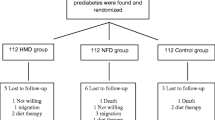Abstract
Objectives
Borderline diabetes, a precursory condition of diabetes, is an important issue in the prevention of diabetes. The aim of the present study was to clarify the effects of one-year changes in obesity and exercise on the development of diabetes or return to normal fasting plasma glucose (FPG) levels among middle-aged people with impaired fasting glucose (IFG) at baseline.
Methods
Among those who attended a basic health examination in 1997, we selected 1,620 subjects who showed impaired fasting glucose (FPG of 110 mg/dl or higher) and had complete data on height, weight and exercise. At the one-year follow-up (in 1998), 1,099 of those subjects attended a health examination; FPG, height, weight and exercise were evaluated for 731 subjects. Subjects were classified into the following three groups, on the basis of changes in FPG during the year between the two examinations: developing diabetes (DM), remaining IFG, and returning to normal (WNL).
Results
Among those who were initially obese, there was a significant difference in the proportions of DM, IFG and WNL between those with and without improvement in obesity in the year preceding the follow-up (p<0.05). Those with improvement in obesity showed a significantly higher tendency to return to WNL than those without improvement in obesity. Multiple logistic regression analysis showed that those with improvement in obesity had a significantly higher odds ratio (2.17) to return to WNL (p=0.015). Among those who were initially not obese, there was no significant association between changes in obesity and developing DM or returning to WNL. No significant association was observed between changes in exercise and developing DM or returning to WNL.
Conclusion
The present findings suggest that, among obese IFG subjects, improvement in obesity is associated with returning to normal plasma glucose. Weight control may be important for the normalization of borderline diabetes.
Similar content being viewed by others
References
Ito C. Incidence and handling of borderline diabetes. Medicina 1993; 30: 1398–1400 (in Japanese).
Kamejima S, Yamashita K. Some comments on ADA and WHO reports on the new criteria for the diagnosis of diabetes mellitus. Nihon rinsho 1999; 57: 556–560 (in Japanese).
Shimao M, Kyo A, et al. Early detection and management of cases of abnormal glucose tolerance. Teishin Igaku 1994; 46: 411–481 (in Japanese)
Egusa G, Okubo M, et al. Transition from IGT to diabetes and high-risk groups. Rinshoi 1996; 22: 20–23 (in Japanese).
Trovati M, Quirico C, et al. Influence of physical training on blood glucose control, glucose tolerance, insulin secretion, and insulin action in non-insulin-dependent diabetic patients. Diabetes Care 1984; 7: 414–420.
Westlund K, Nicolaysen R. Ten-year mortality and morbidity related to serum cholesterol. A follow-up of 3.751 men aged 40–49. Scand. J. Clin. Lab. Invest. Suppl. 1972; 127: 1–24.
American Diabetes Association. Nutritional recommendations and principles for individuals with diabetes mellitus. Diabetes Care 1987; 10: 126–132.
Kahn R. Joslin's diabetes mellitus. 12th ed, Lea & Febiger 1985; 43.
Bierman EL, Bagdade JD, et al. Obesity and diabetes: the odd couple. Am. J. Clin. Nutr. 1968; 21: 1434–1437.
Smith M, Levine R. Obesity and diabetes. Med. Clin. North. Am. 1964; 48: 1387–1392.
Olefsky JM, Kolterman OG, et al. Insulin action and resistance in obesity and noninsulin-dependent type II diabetes mellitus. Am. J. Physiol. 1982; 243: 15–30.
Kashiwagi A, Maekawa S, et al. Obesity as a diabetic risk. Nihon Himangakkai Kiroku 1999; 14: 24–27 (in Japanese).
Kida Y, Ide R. Clinical statistics (3rd Report) of 1000 diabetic patients in the Uji region: obese cases and effects of reduction in obesity. Kyoto Igakkai Zasshi 1997; 44: 19–24 (in Japanese).
Inoue S, Tanaka Y, et al. Obesity and diabetes. Rinsho Igaku 1990; 26: 921–929 (in Japanese).
Goodyear LJ, Hirshman MF, et al. Skeletal muscle plasma membrane glucose transport and glucose trnasporters after exercise. J. Appl. Physiol. 1990; 68: 193–198.
American Diabetes Association. Nutrition recommendations and principles for people with diabetes mellitus. Diabetes Care 1994; 17: 519–522.
Holbrook TL, Barrett-Connor E, et al. A prospective population-based study of alcohol use and non-insulin-dependent diabetes mellitus. Am. J. Epidemiol. 1990; 132: 902–909.
Sasaki A. Epidemiology of IGT and borderline diabetes. Rinsho Igaku 1996; 22: 16–19 (in Japanese).
Emoto M, Oka Y. Does impaired glucose tolerance (IGT) become diabetes? Rinsho to Kenkyu 1998; 75: 92–96 (in Japanese).
Morita N, Yahata N, et al. Study about the factor of improvement and worsing on borderline diabetes. Kotsu Igaku 1996; 50: 26–29 (in Japanese).
The Expert Committee on the Diagnosis and Classification of Diabetes Mellitus. Report of the expert committee on the diagnosis and classification of diabetes mellitus. Diabetes Care 1997; 20: 1183–1197.
Alberti KGMM. Definition diagnosis and classification of diabetes mellitus and its complications. Part 1: diagnosis and classification of diabetes mellitus. Provisional report of a WHO Consultation. Diabetic Med. 1998; 15: 539–553.
Ministry of Health and Welfare, Japan. The 1991 National Nutrition Survey in Japan. Tokyo, Japan: Daiichi Shuppan 1993.
Pan XR, Li GW, et al. Effects of diet and exercise in preventing NIDDM in people with impaired glucose tolerance. The Da Qing IGT and Diabetes Study. Diabetes Care 1997; 20: 537–544.
Baschetti R. Low carbohydrate intake and oral glucose-tolerance tests. Lancet 1998; 352: 1223–1224.
Author information
Authors and Affiliations
Corresponding author
Rights and permissions
About this article
Cite this article
Shimizu, S., Kawata, Y., Kawakami, N. et al. Effects of changes in obesity and exercise on the development of diabetes and return to normal fasting plasma glucose levels at one-year follow-up in middle-aged subjects with impaired fasting glucose. Environ Health Prev Med 6, 127–131 (2001). https://doi.org/10.1007/BF02897959
Received:
Accepted:
Issue Date:
DOI: https://doi.org/10.1007/BF02897959




